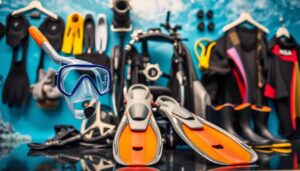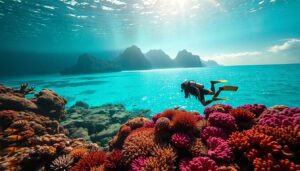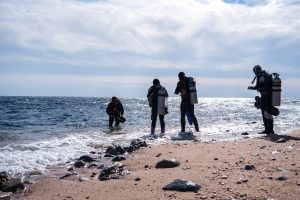
For shark lovers, it’s a must-dive experience to swim with these powerful predators. Luckily, there are many destinations around the world where you can see these stunning fish up close and personal.
One of the best places to dive with tiger sharks is Tiger Beach in the Bahamas, where you can get within reach of multiple sharks at once. It’s also a good spot for lemon sharks and Caribbean reefs, plus hammerheads from January to March.
Aliwal Shoal
Aliwal Shoal is a one-of-a-kind diving location located about 5km off the coast of KwaZulu-Natal, South Africa. Unlike most tropical dive destinations, Aliwal Shoal is not a coral reef but rather a fossilised sand dune that has become rock. It is home to a variety of sharks, hard and soft corals as well as a veritable smorgasbord of tropical and subtropical fish species.
This is a shark lover’s dream come true. Depending on the time of year you may see Giant Guitar Sharks, Hammerheads, Tiger Sharks, Bull and Dusky Sharks and even Whale Sharks. You can also experience the Aliwal Shoal Sardine Run, a diving adventure like no other!
The area is also a popular spot for shark charters and is known as the “Shark Capital of KwaZulu-Natal”. Besides being a great diving destination, Aliwal Shoal is also an important marine habitat for turtles and reef fish.
In addition to a variety of sharks, Aliwal Shoal is home to a number of other creatures including humpback and bottlenose dolphins as well as schools of pelagic fish. It is a popular fishing destination too, especially for ski-boat and spearfishing, so the Aliwal Shoal MPA was developed to reduce user conflict in this area as well as conserve the marine ecosystems that make up the shoal.
The area is divided into several dive sites, starting at 5m and reaching up to 27m. There are a few wrecks around the shoal too, including the SS Nebo (1884) and the MV Produce (1974). Some of the most popular dives in Aliwal Shoal are Raggie Cave (only accessible when there are no sharks), Howards Castle, Eel skin and Cathedral.
Protea
There are a number of places around the world where you can dive with sharks. Whether it’s cage diving with Great Whites at Guadalupe Island in Mexico or swimming with hammerheads on Bimini Island in the Bahamas, these experiences are both exciting and memorable.
The Galapagos Islands are another top scuba destination for shark encounters. These remote, uninhabited islands offer divers a chance to swim with silky sharks, Galapagos sharks, hammerheads and whale sharks in some of the most beautiful waters in the world.
One of the most famous Galapagos scuba sites is Punta Carrion on Santa Cruz, where you can spot large numbers of sharks in relatively easy conditions. There’s also plenty of whale shark action, particularly in the warmer months of January to May, when these powerful predators are more common.
Jupiter is a popular winter destination for lemon sharks, which congregate in the clear water near wrecks and deeper ledges. These yellow-tinged creatures can grow up to 13 feet (4 m) and are a fascinating sight.
Fiji is another great destination for encounters with sharks. Here you can dive on Shark Reef, a protected marine reserve that’s home to eight different species of shark.
South Africa is another popular destination for sharks, especially cage diving with Great White sharks in Gansbaai. This vibrant city is home to a number of dive trips that focus on this iconic animal, which can be seen in a variety of habitats, including in the sea around Seal Island in False Bay and off Simonstown at Cape Point.
Australia is a great place to explore sharks as well. The country’s Southern Ocean offers a variety of dive spots for the opportunity to see humpback whales, manta rays and, from June to September, lemon sharks. You can also explore the underwater world on a liveaboard in the Great Barrier Reef, which features anemone cities and shark reefs with spectacular drop-offs.
Layang Layang
Layang Layang is a coral-blessed, deep sea atoll off Sabah in Malaysia. It is regarded as one of the world’s top diving destinations and has a strong reputation for attracting hammerhead sharks, turtles, big pelagics and schooling fish.
Despite the presence of a small Malaysian Navy base, the island maintains its unique beauty and biodiversity as it is untouched by human encroachment. The pristine walls of the atoll are fed by nutrient rich waters and provide some of the most exciting wall diving in the world.
For those interested in spotting sharks, the main draw card of Layang Layang is its excellent opportunity to dive with schooling scalloped hammerhead sharks between March and May when they congregate around the atoll for their mating rituals. In addition to the sharks, Layang Layang offers a wealth of other marine life including cruising manta or devil rays, giant trevally and tuna.
There are also some great snorkelling opportunities and a bird sanctuary where swallows, egrets, brown foot boobies and crested terns find a safe haven on an undisturbed island. The island also has a modest resort and dive facility as well as a small Malaysian Naval base and a 1,400-metre runway.
It is estimated that up to 20,000 divers visit this island annually, with most coming from Europe and Asia. This is an important tourism industry for Malaysia and has a positive impact on the economy.
Tiger Beach
Tiger Beach is one of the most famous scuba diving sites in the world for shark encounters. The pristine waters of West End, Grand Bahama Island, attract thousands of visitors each year to see the tiger sharks that congregate here.
Diving with tiger sharks is one of the most thrilling experiences for any diver. The sharks are here all year, but they tend to be at their most active between October and January, when they are in their winter gestation period.
This is also the best time to see other shark species, including nurse sharks, great hammerheads and Caribbean reef sharks. Other animals you might see in these waters include moray eels, large groupers, snappers, dolphins and sometimes even loggerhead turtles!
While the tiger sharks are the most popular attraction, you can also see lemon sharks and a variety of other fish and coral. This is a good site to explore with your family, as you can see a lot of different species at once and it is easy for everyone to find something interesting!
There are a few important things you should know before diving with tiger sharks at Tiger Beach. Firstly, you should have a minimum of an Open Water certification. You should have experienced a few dives in deep water and you should be aware of the varying depths, currents and shark species.
Secondly, you should have an awareness of the sharks’ behavior patterns and how they interact with divers. This will help you avoid any unnecessary accidents that might occur during the shark encounter.
Seeing tiger sharks in their natural environment is a great experience for all divers, but it can be intimidating at first. After a while, you will get used to their presence and you will begin to enjoy the experience more.
St Johns
St Johns, a Caribbean island with a rich history, is surrounded by crystal-clear waters and thriving marine life. It’s the perfect place to get certified for scuba diving or take a day trip to see some of the world’s best reefs.
The best scuba diving sites in St John for shark encounters include:
Eagle Shoals, located on the east end of Saint John between Leduck Island and Ram Head, is home to a dazzling array of arches, tunnels and caves. It’s most famous for a multiple entrance cavern called ‘The Cathedral’ that’s encrusted with vivid sponges and orange cup coral. Silversides, porkfish and black durgeons have also made this their home.
Cow Rock, a sister site of Thatch Cay, is another great choice for snorkeling on St. John because it offers a shallow, scenic bay with sea grass beds and patch reefs.
It also has a variety of nooks and crannies that offer shelter for squid, octopus and nurse sharks. This site is also a favorite for night diving, as it’s home to a huge number of corals and fish that feed well at dusk.
Tektite, an abandoned underwater laboratory, is an exciting spot for history buffs. Its enigmatic tunnels and ledges are encrusted with colorful coral and are a favorite of triggerfish, tarpon and mackerel.
Carvel Rock, also known as ‘The Cow and the Calf,’ is one of the most interesting sites on the north side of St. John and can be accessed by dive centers from St. Thomas and elsewhere in the Virgin Islands.
The ruins of Annaberg Plantation, Forest House and Kelvin House are all easily accessible and worth exploring for the unique architecture. It’s also possible to hike to the Windy Hill Ruins, a set of three historic buildings that sit atop Waterlemon Cay and Leinster Bay.







